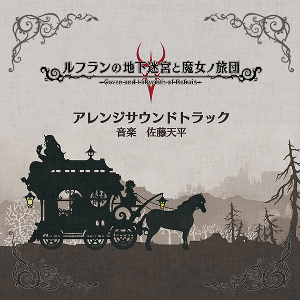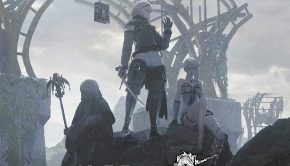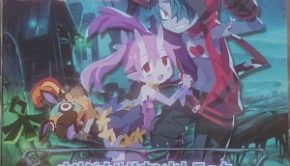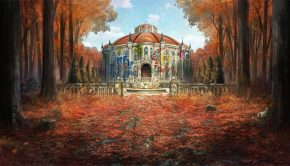Coven and the Labyrinth of Refrain Arrange Soundtrack
 |
Album Title: Coven and the Labyrinth of Refrain Arrange Soundtrack |
| Record Label: MissKissDisc |
|
| Catalog No.: MKDS-0004 |
|
| Release Date: December 26, 2016 |
|
| Purchase: Buy at Amazon Japan |
Overview
As with many of Tenpei Sato’s soundtracks for Nippon Ichi Software, he typically releases an arrange soundtrack afterwards on his own label. With his last album, Witch and the Hundred Knight Arrange Soundtrack, there were definitely improvements compared to some of his Disgaea arrange soundtracks. Does this trend continue with his latest arrange soundtrack for Coven and the Labyrinth of Refrain Arrange Soundtrack?
Body
The album opens with “Draw Near,” a playful, quirky piece in the vein of Disgaea with a large focus on accordion and vocals. With the arrange version, there is an added slower section in the middle that exudes more mysterious air and helping give the piece a more intriguing progression. It certainly improves upon the original. On the flip side of things, “Witch’s Depression” is a more mysterious and haunting piece to start, with a bit of a gypsy vibe going for it. The added section in the middle adds a more jovial touch to the piece, offering a bit of a Renaissance sound with woodwinds that adds a bright mood to the piece. “Moonlight Piano” is a piano and strings driven tune with both beautiful atmosphere and melody with a choral backing that brings a haunting quality to the piece with a more romantic flair thanks to the smoky, jazz piano featured in this take.
“Toy Box” features a playful melody, magical atmosphere, and a focus on woodblock instrumentation while adding a soft piano driven section that gives off an innocent air thanks to its ethereal choir and soft electronic touches. It certainly conjures up an image of a child playing with his toys, but I’m not sure if this was the intended portrayal. “Fairy Doll” remains largely unchanged with its flamenco guitar, accordion, woodwind, and harpsichord combination that give off a bit of a Baroque sound mixed a Renaissance flair; however, the addition of a violin solo gives off a bit more of a festive, yet reflective, sound to fit with the rest of the piece’s overall tone. “More Than Words” is a poignant piano driven piece that becomes a bit more vocal focused compared to the original, giving it more of a soft pop ballad flavor. It is enjoyable but comes off as a bit saccharine.
The main theme, “Labyrinth of the Refrain,” certainly carries the same spirit of the original, but does improve thanks to the addition of live violin instrumentation; however, there aren’t any major additions or changes to this theme. “Rose Bed,” also steeped in Baroque influence with its strings and harpsichord focus, also improves by adding some more classical texture, this time in the form of a strings driven waltz section. Another piece that doesn’t add a whole lot aside from instrumentation updates and solos to give it a bit more edge is “Green Blood.” It still has the same musical texture of the original and is still certainly enjoyable piece but doesn’t do as much as some of the other pieces on the album.
One of the more successful transformations is “Lost Ruins.” While the haunting choir and strings of the original are still intact, the addition of male choir adds a much more complex tone to the piece with an almost religious overtone that accentuates the original’s mystical and, at times, desperate sound. My personal favorite of the album is “Detuned Beat,” which takes a more typical rock driven battle theme, amps up the energy during the more rock oriented section, but opens up with a stunning piano section that ties together the classical style heard in many of the softer pieces to great success. With “Recollection,” another classically influenced piano piece done in a waltz theme also doesn’t drastically change, but has a more romantic feel thanks to the new subtle piano additions.
The vocal theme, “A the ha lluri da,” sung by Emi Evans, follows in the footsteps of past vocal arrangements by updating the instrumentation and extending the original’s run time. As with the original, it blends ballad stylings with modern Japanese language with a futuristic take on Welsh while also conveying a lot of emotion in its strong melody. Likewise, the piano rendition of “A the ha lluri da”, becomes a bit more classically influenced, and also sees an update with the addition of strings that give it a more poignant and romantic air that borders on fairytale-esque in nature.
Summary
While Tenpei Sato’s arrange soundtracks may not be as groundbreaking or avant garde as other arrange albums released for various game soundtracks, they typically highlight some of the more popular and successful tunes on the respective soundtracks. They also give a chance for those unable to purchase the soundtrack, due to the more pack-in nature of Nippon Ichi Software’s soundtracks, a chance to hear a good representation of the overall soundtrack. While some of the tunes on this album certainly change drastically, they all retain their overall feel. Either way, the music of the original was one of his strongest efforts in recent years and while not perfect, this arrange soundtrack certainly is another step in the right direction.
Do you agree with the review and score? Let us know in the comments below!
4
Posted on March 30, 2017 by Don Kotowski. Last modified on March 30, 2017.















Looking over his discography, I realize I’ve never heard a Sato soundtrack. Where should I begin? And incidentally, I’m madly in love with this album’s cover art.
Hmm, well, he’s most famous for Disgaea, and out of those, I’d say the 1st and 4th are his best from that series, but I have a sweet spot for Phantom Brave and Soul Cradle. Recommendations from the former include: Strange Wind, Sand Shower, and Violent Emotion. For Soul Cradle, I recommend: Flaxen Necklace, The Last Supper, and Crying for the Dark Sky.
Of course, the original soundtrack to this game is also a good place to start. Ask Emily!
I’ve been absolutely addicted to the arrange album. It’s basically the original with some added measures and updated instrumentation, but Coven is such a fun OST that I’m happy to have more. Agreed about Detuned Beat – it wasn’t my favorite in the original, but the guitar at the end on this album makes it my favorite arrangement.